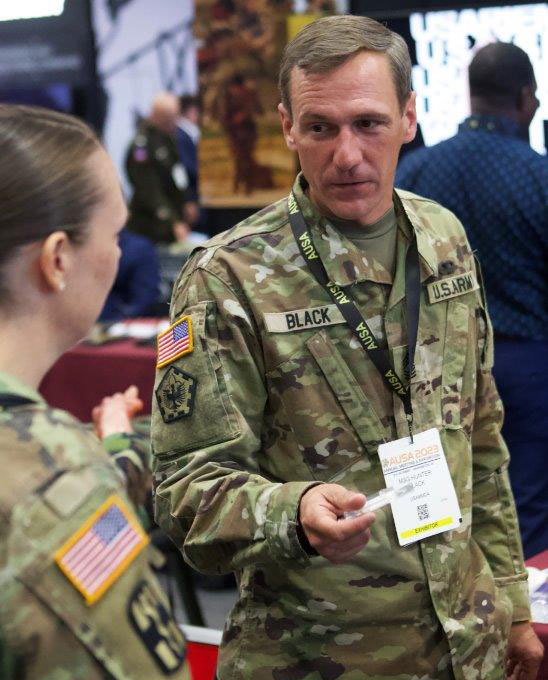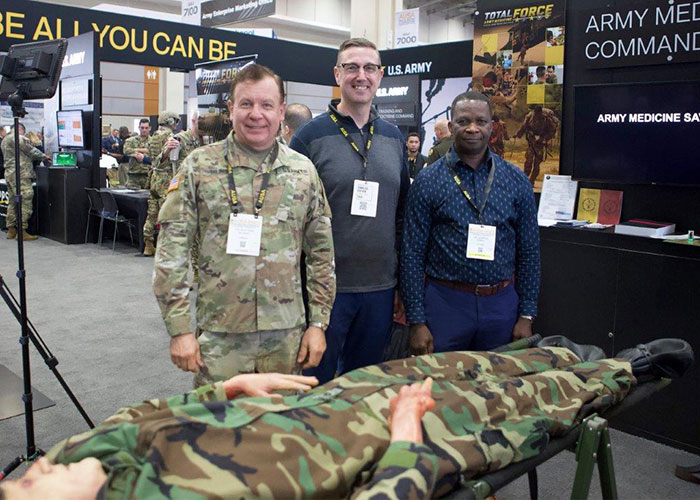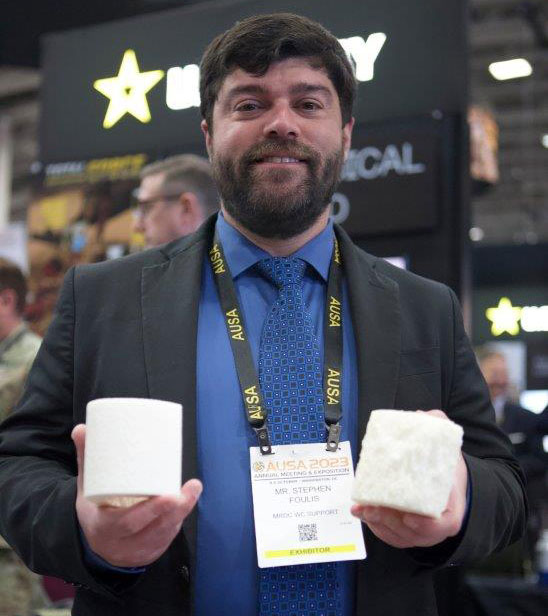MRDC Showcases Military Medicine Advancements at AUSA 2023

The U.S. Army Medical Research and Development Command demonstrated a range of emerging technologies designed to address urgent challenges in large-scale combat operations and improve return-to-duty rates at the 2023 Association of the United States Army Annual Meeting & Exposition in Washington, DC, on October 11, 2023.
Representatives from MRDC's Institute of Chemical Defense, Institute of Environmental Medicine, and its Medical Materiel Development Activity were on hand to answer questions about how MRDC is working to improve the treatment of chemical and biological casualties, reduce injuries in basic training and develop wearable products that help improve Warfighter performance in the field.
Focused on the theme of "Training for the Reality of War," AUSA's Annual Meeting is the largest land power exposition and professional development forum in North America. Over 33,000 attendees and 650 exhibitors were expected to attend the three-day event in the heart of the Nation's capital. In addition to two exhibit halls, the event included a full calendar of presentations, panel discussions, networking opportunities and seminars on up-to-the-minute military and national security topics.
At the event, USAMRICD discussed three new training courses developed in partnership with MRDC's Research Institute of Infectious Diseases: Field Management of Chemical and Biological Casualties, Field Management of Chemical and Biological Casualties, and Hospital Management of Chemical, Biological, Radiological, Nuclear, and Explosive Incidents. The courses are open to medical professionals in all Services and count toward their continuing education credits.
The centerpiece of ICD's AUSA display was the Customized Human Patient Simulator, a life-size mannequin exhibiting a variety of chemical, biological and explosive injuries. Col. Slavomir Bilinski, Chief of the Chemical Casualty Care Division, explained the mannequin is used in the training courses, which are an effective way to expose medical professionals of all backgrounds — not just doctors and nurses — to the various types of injuries they are likely to encounter in combat environments and the methods for treating them.

"For example, explosive ordnance disposal experts would benefit from taking our courses because when there is an incident, they are often the first people on the scene," Bilinski said. "In our courses, we introduce people to the range of things they might encounter, and we can drill down as deeply as they need."
Dr. Stephen Foulis, a research physiologist with USARIEM, attended AUSA to share the findings of the Reduction in Musculoskeletal Injury Study, which followed 4,000 Soldiers for five years, collecting comprehensive medical data through bone density scans, blood work, psychological surveys, medication history and even their eating and sleeping patterns. Foulis said that the study has already resulted in numerous papers that are being published in peer-reviewed journals and that there are several interesting outcomes from the study that can help trainers and Soldiers alike prevent injuries in basic training.
"Our data has helped inform the Future Soldier Preparatory Course to help identify people who are not quite fit enough to enter basic training," Foulis said. "For example, we've found that trainees who take non-steroidal anti-inflammatory drugs are five times more likely to experience stress fractures. We also found that individuals who have higher levels of psychological hardiness are 20 percent less likely to experience injury during basic training."

USAMMDA displayed a wide range of innovative new products designed to help improve the health and readiness of Soldiers, including the Health Readiness and Performance System, an integrated system of wearable sensors that provides leaders with actionable information to improve performance and mitigate non-battle injuries during training and operations; and extended-shelf-life blood products that can be deployed in austere environments such as cold-stored platelets, freeze-dried plasma and safe whole blood that are essential for providing timely combat casualty care that improves survival rates.
One of the technologies USAMMDA demonstrated at AUSA was the Analyzer TBI, an FDA-approved diagnostic tool that detects traumatic brain injuries quickly with just a few drops of blood. Master Sgt. Hunter Black explained that the analyzer provides a readout in real time that helps medics make treatment decisions on the spot.
"The device provides an indication of whether biomarkers for TBI are elevated or not, which lets you know whether you need to send the Solider to get a CT scan or an MRI," Black explained. "It makes the process simple. If their blood sample doesn't show up elevated and they're not showing other signs of TBI, you can send them back to the front line. It's all about returning people to duty as soon as it's safe to do so."
The technology displayed at AUSA 2023 is a sampling of the many innovations currently under development at MRDC. These innovations are a demonstration of MRDC's commitment to ensuring the Army meets its war-winning future readiness capabilities by prioritizing people, delivering the Army of 2030 and designing the Army of 2040.














